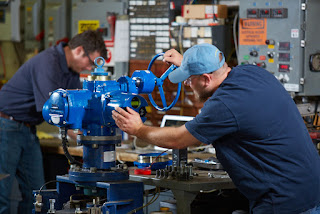 |
| Electric Actuator Assembly (Limitorque) |
There are other motive forces used for valve actuators, including hydraulic and pneumatic, but electric actuators carry their own particular set of operating characteristics that make them an advantageous choice for many applications.
Valve actuators are available in uncountable variants to suit every application scenario. There are three basic valve actuation motions.
- Multi-turn, with repeated rotations of the valve shaft needed to move the valve trim from fully open to fully closed. A gate valve is a multi-turn valve. These are also called linear, with respect to the motion of the closure element. The term "linear", in this case, refers only to the movement of the valve trim and not the flow characteristics of the valve.
- Part Turn, where a 90 degree rotation of the valve shaft produces a change from opened to closed. Ball valves are in this category.
- Lever, generally associated with damper control.
 |
| Completed Electrically Automated Valve |
There are numerous considerations to take into account when selecting an electric actuator.
- Torque needed to effectively operate the subject valve.
- Actuator enclosure type - wash down, hazardous area, dust, etc.
- Service area for the assembly - corrosive environment, temperature extremes, and more
- Valve movement - linear, multi-turn, part turn, lever
- Operation mode - open and close only, positioning, modulating
- Frequency or duty cycle - infrequent, frequent, or almost continuous positioning
- Communication - How will the local controller communicate with the central control system?
- Electrical - What electric power characteristics are available for operation?
- Protections - Motor overload, torque limit, others
- Process Safety - Among other things, what happens if power fails?
There are certainly other elements to consider when applying an electric actuator for industrial use. Share your valve and actuator requirements and challenges with product specialists, combining your process knowledge with their product application expertise to forge the most effective solutions.
https://swansonflo.com
800-288-7926
